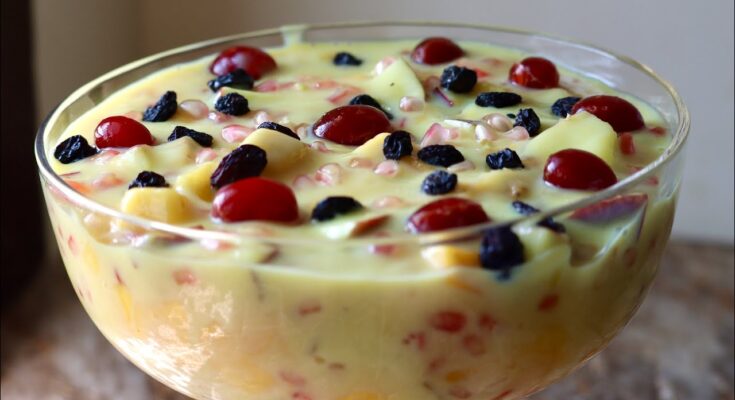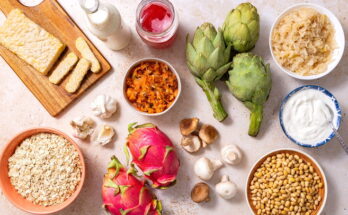Custard Recipe: Custard is a creamy, luscious dessert that has stood the test of time. Whether it’s served warm or chilled, it is a treat that complements a variety of dishes or stands proudly on its own.
From classic vanilla to rich chocolate variations, custard has a universal appeal and numerous styles that differ by region. Think about the French crème anglaise, British custard pudding, or Asian egg tarts – each has its unique twist.
Let’s dive into the art of making custard step by step.
Ingredients for Custard
To make a basic custard, you’ll need:
- Milk or Cream: Adds richness and body.
- Egg Yolks: The backbone of custard, responsible for thickening.
- Sugar: Provides sweetness.
- Vanilla Extract or Pod: For that classic aroma and flavor.
Pro Tips:
- Use fresh, organic eggs for the best texture.
- Full-fat milk or cream delivers a richer custard.
- Opt for granulated sugar for smooth consistency.
Essential Tools for Making Custard
Here’s what you’ll need:
- Whisk: To ensure smooth blending of ingredients.
- Saucepan: For gently heating the milk.
- Fine Mesh Strainer: Removes lumps for a silky texture.
- Thermometer (Optional): Helps monitor temperature to avoid overcooking.
Investing in these tools can make your custard-making experience seamless, but even basic kitchen equipment will suffice with some care.
Types of Custard
- Stovetop Custard: Prepared on the stovetop, ideal for pouring over desserts like pies or puddings.
- Baked Custard: Firm and set, often baked in ramekins, as in crème brûlée.
- Chilled Custard: Creamy and cold, used as a base for ice creams or trifles.
Each type has a distinct texture and use, allowing you to tailor your custard to your specific needs.
Step 1: Preparing the Ingredients
Start by gathering and measuring your ingredients. This is crucial because custard requires precise ratios for the perfect texture.
Tips:
- Let the eggs come to room temperature to prevent curdling.
- Pre-measure sugar and milk to streamline the process.
Step 2: Heating the Milk
Pour milk into a saucepan and heat it gently over medium-low heat until it’s warm but not boiling. A slight simmer with tiny bubbles around the edges is perfect.
Avoid:
- Overheating, which can scorch the milk and ruin the flavor.
Step 3: Mixing the Eggs and Sugar
In a separate bowl, whisk the egg yolks and sugar together until the mixture turns pale and creamy. This step incorporates air, giving the custard a smooth and light finish.
Pro Tip:
- Use a hand whisk for better control over the consistency.
Step 4: Tempering the Eggs
This step is where many home cooks hesitate, but it’s easier than it sounds. Gradually add the heated milk to the egg mixture, a ladle at a time, whisking constantly. This method ensures the eggs don’t scramble.
Why is it Important?
- It slowly raises the temperature of the eggs, preventing curdling.
Step 5: Cooking the Custard
Transfer the tempered mixture back to the saucepan and cook over low heat. Stir constantly with a wooden spoon or silicone spatula, ensuring the mixture doesn’t stick to the bottom.
How to Know It’s Done:
- The custard should coat the back of a spoon, and when you run your finger across it, it leaves a line.
Step 6: Adding Flavors
Now comes the fun part: infusing your custard with flavors to elevate its taste. While vanilla is the classic choice, you can get creative with the following options:
- Vanilla Extract or Pod: Add a teaspoon of vanilla extract or scrape the seeds of a vanilla bean into the custard.
- Chocolate Custard: Stir in melted dark chocolate for a rich, indulgent treat.
- Citrus Zest: Add a hint of lemon or orange zest for a fresh, tangy twist.
- Spices: Experiment with cinnamon, nutmeg, or cardamom for a warming flavor.
Tip: Add these ingredients after cooking the custard to retain their full aroma and taste.
Step 7: Straining the Custard
Even the most experienced cooks strain their custard, and here’s why: it guarantees a silky, lump-free texture. Pour the cooked custard through a fine-mesh sieve or cheesecloth into a clean bowl.
Benefits of Straining:
- Removes any cooked egg bits.
- Ensures a smooth, creamy consistency.
For extra finesse, tap the sieve gently with a spoon to help the custard pass through without forcing any solids.
Step 8: Cooling the Custard
Cooling is essential for custard that’s meant to be served chilled or used as a filling. Follow these steps:
- Transfer the strained custard to a shallow dish to cool quickly.
- Cover the surface with plastic wrap to prevent a skin from forming.
- Allow it to reach room temperature before refrigerating.
Tip: Place the custard over an ice bath if you need it to cool faster.
Serving Suggestions
Custard pairs wonderfully with a variety of desserts and garnishes:
- Over Fruit: Serve warm custard draped over fresh berries or baked apples.
- With Pastries: Use it as a filling for éclairs, tarts, or cream puffs.
- Standalone Dessert: Chill it in ramekins and garnish with grated nutmeg, caramel drizzle, or chocolate shavings.
For a fancy twist, use a blowtorch to caramelize sugar on top for a crème brûlée finish.
Common Mistakes and Fixes
1. Curdled Custard
- Cause: High heat or insufficient stirring.
- Fix: Strain it immediately through a fine sieve and blend with a handheld blender.
2. Runny Custard
- Cause: Undercooking or improper ratios.
- Fix: Return it to low heat and cook while stirring until it thickens.
3. Scorched Milk
- Cause: Heating milk too quickly.
- Fix: Start over, as burnt milk flavor is difficult to mask.
FAQs about Custard Recipe
Custard is a beloved dessert enjoyed worldwide, known for its creamy texture and delicate flavor. Here are some frequently asked questions to help you master the art of making custard at home.
1. What are the key ingredients in a custard recipe?
Custard primarily requires eggs, sugar, and milk or cream. Vanilla is often added for flavor, and cornstarch can be used to thicken recipes that need to be more robust.
2. How do I prevent my custard from curdling?
To prevent curdling, cook custard over low heat and stir constantly. Ensure your eggs are tempered by gradually introducing them to the hot mixture to avoid cooking them prematurely.
3. Can custard be made without eggs?
Yes, egg-free versions of custard can be made using cornstarch or similar thickeners as substitutes. These ingredients provide the custard-like texture without using eggs.
4. How long can I store homemade custard?
Homemade custard can be stored in the refrigerator for up to three days. Ensure it’s covered with plastic wrap or in an airtight container to prevent a skin from forming on the top.
5. Is it possible to freeze custard?
Freezing custard is possible but may alter its texture. To minimize texture changes, stir the custard well once thawed and consider using it in baked recipes where the difference will be less noticeable.
Conclusion
Custard is a versatile and timeless dessert that adds a luxurious touch to any meal. With these steps, you can master the art of making custard from scratch. Remember, practice makes perfect, so don’t be afraid to experiment with flavors and techniques. Once you’ve perfected the basic recipe, the possibilities are endless.



